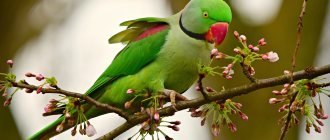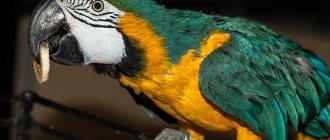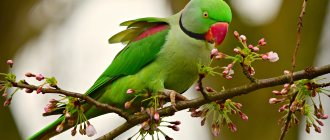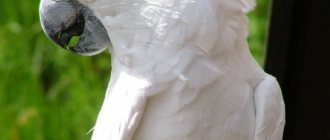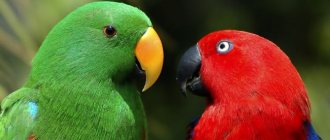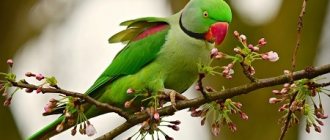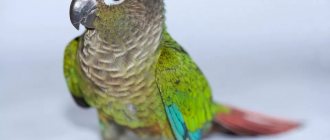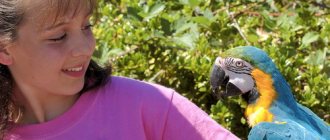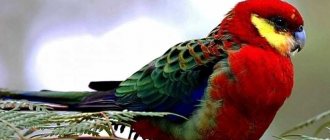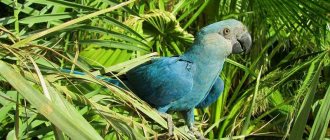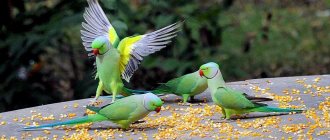- Wild animals
- >>
- Birds
Alexandrian parrots enjoyed the greatest popularity back in the days of Ancient Rome. It was then that it was considered a privilege and a sign of belonging to high society to have an amazing bird as a pet. Today, this type of bird is not so popular, but its mental and intellectual abilities, as well as its learning speed and ability to speak, are truly impressive. The Alexandrian parrot is characterized as a calm, friendly and very sweet bird. Often, when well cared for, they show feelings of affection for their owner.
Origin of the species and description
Photo: Alexandrian parrot
Alexandrine parrots are representatives of chordate birds, classified into the order Psittacidae, the family Psittacidae, the genus of ring-necked parrots, and the species of Alexandrine ring-necked parrot.
The first mention of Alexandrian parrots dates back to the period of Ancient Rome. At that time, representatives of the local nobility kept them as pet birds, kept them in gilded cages, and even often hired teachers to train them. In those distant times, a bird was worth more than a good, strong slave.
Birds were brought to the territory of modern Europe by Alexander the Great in the fourth century. The soldiers of his large army brought the birds to Europe during the period when they were returning from a campaign in Asia. This species of bird was named in honor of Alexander the Great.
The demand and excitement around the amazing birds arose after they managed to save the great warrior and conqueror. There is a story when, during one of the battles, the army of Alexander the Great was almost completely defeated, and the enemies tried to capture the leader himself. However, at his most dangerous moment, several birds broke out of their cages and fearlessly rushed towards the invaders. They, in turn, rushed to catch the birds, but were unable to do so. However, as soon as Alexander the Great called them to return to their cells, they immediately obeyed him.
Optimal age for training
Regarding when budgerigars begin to speak, we can definitely say when they are ready. The statement - the earlier you start training, the better, is true here. Usually a bird for home is purchased at the age of about a month. It is impossible to guarantee that you will select a budgerigar so that it speaks; the abilities do not appear immediately. One thing is for sure - you should choose the smallest ones, a month to one and a half years old.
The distinctive features of young parrots are:
- large round dark eyes, monochromatic, since the light iris appears only at 5 months;
- the tail and wings are noticeably short;
- the feathers on the forehead, directly from the cere, have a wavy pattern, and after 3 months - the time of the first molt, a light spot forms on the forehead;
- at the end of the beak there is a dark smear, becoming lighter with age.
All differences disappear within 3–4 months, after which it is difficult to determine the age of the bird.
Each chick is an individual, but in general, until they are one month old, they are not sufficiently independent. From the first acquaintance, school actually begins for the parrot, and it is better to start regular classes later. At first, it is useful to win over a newcomer, to tame him a little, by saying a stable set of simple words during communication - saying his name, praising his beauty and intelligence, inviting him to eat. It is interesting that the baby begins to listen carefully, bowing his bright head.
Appearance and features
Photo: Bird Alexandrine parrot
The Alexandrian parrot is one of the most striking and largest representatives of the ringed genus. This bird has a rich, grassy green color, which in the back of the head has a beautiful blue tint. The parrot's beak is quite large and curved. In young individuals it is orange, in adults it is a rich, red color.
Video: Alexandrian parrot
There are marks on the body of a different color from the main one - in the area of the shoulder blades there is a brown spot, and in the forehead area there is a dark, almost black mark. A dark stripe runs from the beak area along the lower side of the head to the crown. In males in the second year of life, a so-called necklace appears in the neck area - bright pink on top and dark brown or black on the sides. From this necklace, a dark stripe called a tie runs down the chest.
These birds have a number of distinctive features:
- massive, large beak;
- large head;
- quite large body, the size of which reaches 50-60 centimeters;
- long, straight downward-pointing tail;
- the presence of dark red patches on the wings;
- significant wing span, which reaches 20-22 centimeters.
This species of birds has pronounced sexual dimorphism - the female is smaller in size compared to the males and does not have a bright necklace in the neck area. Ornithologists note that it is the large size and the presence of colored patches on the wings that are considered to be the main distinguishing features of the Alexandrian parrot.
Silence due to illness
An important point is silence due to illness. But besides silence, owners will need to know other signs that may result from the disease:
- Loss of appetite and the pet stops consuming water.
- The parrot is constantly sleeping or has huddled in a corner and is ruffled.
- Does not react in any way to the environment and irritants.
- The pet is constantly itching.
- The wax on the beak has changed its color and structure.
- The parrot stopped eating the treats that he previously loved.
- A cough appeared.
- The color of the plumage loses its saturation and the parrot itself looks unkempt.
Such symptoms, together with the absence of chirping, are very life-threatening. This may indicate an infection in the body or the presence of parasites. These symptoms also occur with colds. If one of the signs is detected, you should immediately seek help from a doctor, who can accurately prescribe treatment and make a diagnosis.
Where does the Alexandrine parrot live?
Photo: Alexandrian parrot
Alexandrine parrots naturally live mainly in regions of humid forests. The geographical regions of their distribution are very diverse, depending on the subspecies. They prefer to be located at the very top of tropical thickets. They rarely descend to the surface of the earth.
Geographical regions where birds live in natural conditions:
- India;
- Pakistan;
- Afghanistan;
- Iran;
- Madagascar;
- Israel;
- Sri Lanka;
- Andaman Islands;
- Myanmar;
- Vietnam;
- Laos.
Small populations of Alexandrine or necklace parrots can be found in natural conditions in Belgium or Germany. Previously, the islands of Reunion and Rodrigues were inhabited in large numbers. Currently not available in these regions. Alexandria parrots are considered excellent sprinters, but they tend to fly only short distances.
They can often settle in close proximity to agricultural land, which causes significant damage to the crop; they especially like to visit corn fields and feast on juicy cobs. When not flying, they most often hide in the crowns of tall trees. At night they can also be very active and fill the crowns of tall trees with huge flocks, the number of which reaches several hundred, and sometimes thousands or more.
In many countries around the world, this type of parrot lives as pets, or is raised and bred in special nurseries and zoos. They quickly adapt to new living conditions and feel quite comfortable as pets.
Habitat, lifestyle
Ringed parrots live in African and South Asian countries - India, Sri Lanka, Iran, Pakistan, Vietnam, Laos. Geographical areas vary among individual subspecies. Alexander's parrot is a bird that is characterized by living in a flock. Birds bearing the name of the Macedonian king inhabit tropical forests. They prefer the upper tiers of old, hollow trees. They are cautious and know how to protect themselves from poachers.
Alexandrians are hardy, fly well, and therefore can easily cover long distances. However, they usually do not have to make long flights: the natural environment of the tropics is fertile, and there is enough food for everyone. However, birds sometimes fly into maize fields and destroy the unripe crop.
Parrots cause serious damage to the agricultural industry. This is one of the factors in population decline.
What does the Alexandrine parrot eat?
Photo: Alexandrian necklace parrot
When living in natural conditions, necklace birds are quite voracious and completely unpretentious. They feed on almost everything that can be suitable as food for birds. These are cereals, seeds of various types of vegetation, corn, fruits of fruit plants and trees, etc.
If a parrot is kept at home, it needs a varied and balanced diet, as this directly affects the health of the bird. A mandatory component of the daily diet of domesticated birds is balanced mixtures for parrots.
They contain in an optimal ratio grains, vitamin complexes, minerals, and other substances necessary for the full functioning and health of the bird. The daily food intake for one adult bird is 50-60 grams of food.
Mandatory components of the daily diet of poultry:
- carrot;
- zucchini;
- beans;
- beet;
- zucchini;
- cucumbers;
- apples;
- plums;
- oranges;
- apricots;
- seeds;
- soaked white bread;
- fresh greens.
Potatoes, onions and eggplants are strictly prohibited. Millet in spikelets is considered a special delicacy. This delicacy should be given in moderation - no more than two ears of grain per day.
Foods that can harm your parrot's health:
- raw eggs;
- honey;
- sugar;
- products containing chemicals and artificial food additives, dyes.
During the period when birds are molting, you can add several sesame grains to the feed mixture, as well as add vitamin supplements. The owner of the handsome feathered creature must ensure that he always has access to clean drinking water. Parrots enjoy eating homemade porridge: rice, buckwheat, oatmeal, corn, etc. Porridges are prepared in water without adding salt, sugar, flavorings or spices. They must be served freshly prepared, slightly warm.
Features of character and lifestyle
Photo: Alexandrian ring-necked parrot
Alexandria parrots quickly get used to new living conditions and people. To owners who can provide good care and living conditions, they express their affection and affection. Birds have a good-natured, calm and inquisitive character. Scientists and researchers even claim that birds are endowed with intelligence and intelligence. Birds are undemanding and not picky about their living conditions. All they need is a spacious cage, a balanced diet, water treatments, 1.5-2 hours of free flights per day, the attention of the owner, and his love.
Birds are considered excellent singers and have a strong and sonorous voice. I can sing beautiful, lingering trills for a long time. Starting from the age of three months, parrots can be taught to speak. They learn quite easily and can remember a large number of words if they feel comfortable and safe. The fact that the pet has become comfortable and is ready to completely trust its owner is evidenced by its behavior. He gladly accepts food from the hands of his owner, sits on his shoulder, in his arms, does not flinch and is not frightened by third-party rustles.
When living in natural conditions, they spend most of their lives in the treetops of tropical forests. Most often they gather in small flocks of up to ten individuals. Particular sensitivity and emotionality of birds is observed from January to the end of March. Parrots nest during this period of time.
Birds love rain and water treatments. When living in natural conditions, they frolic and play in the rain. Therefore, when kept at home, it is sometimes necessary to create conditions for birds to undergo water procedures.
Singing budgerigars
Those who encounter budgies for the first time are unlikely to call their trills singing. Their songs are more like ringing chirping or rustling. But in fact, these birds are very musical.
In the wild, the noise made by a flock of parrots can be heard from afar. On the one hand, this is a kind of roll call between birds, and on the other hand, it is a protective maneuver (one manages to scare away predators with one’s noisy chirping).
According to the observations of ornithologists, birds even have their own special names-sounds, when uttered they identify each other. The morning in the pack begins with a rally and a loud “meeting”, where the issue of the plan of action for the day is “resolved”. From the side it looks like an orchestra warming up - everyone is shouting, making noise, everyone is trying to out-shout the other. And then at one moment, having communicated, the flock scatters about its business.
During the mating season of budgies, their loud trills lose their power, and in their place you can hear the quiet grumblings of males, who are trying to attract females with their soulful singing. All this, but on a smaller scale, can be observed at home when breeding feathered pets.
Listen to the budgies chirping
Video of a budgerigar tweeting
What do the different sounds of budgies indicate?
The sounds of a budgie are not just chirping, but real bird conversation that has its own meaning. It has been proven that the speech of the budgerigar is very developed. This is not just imitation of sounds or noisy chirping, but completely full-fledged communication. Scientists managed to classify their dialect and divide it into subgroups.
| Type of "talk" of a budgie | What does it mean? |
| Peeping, chirping (“peek”, “chwik”, “pew” or “chirp”). | The bird is happy, calm, but tries to interact with the world around it, to get to know it. |
| The singing of wavy birds (quiet, unobtrusive chirping, “tuyu-tuyu-chvik”). | Speaks of good health and good mood. |
| Talking (similar to rustling). | Calm communication between birds. |
| Rokot (“kwe”, “e”). | The chick is tired, wants to sleep, asks not to disturb. |
| Screams (“cha-cha-cha”). | The parrot is agitated, something is bothering him or he is in danger. |
| Muttering (“kvya”, “kwi”). | Can be heard through direct contact with the parrot by picking it up; this is how the bird tries to get acquainted, but at the same time asks not to bother it too much. |
| Cooing. | A unique trill that birds make during the mating season. |
Social structure and reproduction
Photo: Alexandrian parrot
The breeding season when living in natural conditions occurs from March to November. During this period, birds form pairs. The male shows incredible care for the female. The female lays from one to four to five eggs. 28-30 days after laying, the chicks are born. Throughout this period, the female incubates the eggs, and the male takes care of her, obtains and brings food.
Chicks are born completely helpless and practically naked. However, they quickly grow stronger and become covered with feathers. The first time babies emerge from their shelter is at 4-5 weeks. The offspring that hatch from the eggs remain in the nest for up to 7-8 weeks. During this entire period, their parents take full care of them. Upon reaching this period, they leave the place of birth and lead an independent lifestyle.
Alexandria parrots reach sexual maturity in a period of 12 months. Individuals aged from one to three years participate in reproduction.
The average life expectancy of this species of birds in natural conditions is 25 years. When living at home and with good care, this figure can double. Breeding Alexandrian parrots at home is an extremely difficult and difficult task, since a pair of birds is selected not by the owner, but by the bird itself. During the breeding season, it is necessary to provide your pets with a balanced, nutritious diet. Lack of the required amount of minerals and vitamins can lead to the death of offspring and their parents.
The second important point when breeding parrots at home is organizing a nesting site. It is best if, on the territory of a spacious cage, the owner organizes a wooden house, the height of the walls of which will be at least 10 centimeters. It is best to cover the bottom of such a house with dried grass or sawdust.
Price
Song parrots are not rare and are not difficult to find for sale. The price for these birds is usually 3000-7000 rubles. The cost of a particular bird depends on its age, gender and color variation. Males sing and are brighter in color, so they usually cost more.
Song parrots are beautiful and interesting birds to watch with a pleasant voice. They do not emit sharp screams and are not prone to destruction. When walking around the apartment, they do not chew furniture. In addition to natural colors, there are selectively bred morphs, which makes breeding these birds interesting. Song parrots are highly tamed, but are not able to imitate human speech. With proper care, these birds can live 15-25 years. The disadvantages of this species include difficulty getting along with other parrots, the need for pair housing, and sensitivity to low temperatures.
If you liked the article or have something to add, leave your comments and also join our VKontakte group.
Natural enemies of Alexandrine parrots
Photo: Bird Alexandrine parrot
When living in natural conditions, birds have quite a lot of enemies.
The main natural enemies of Alexandrian parrots:
- stoats;
- opossums;
- large lizards;
- large feathered predators.
When living in natural conditions, bird nests are often plundered and destroyed by predators, lizards and other representatives of the local flora and fauna.
Humans pose a particular danger to Alexandrian parrots. Local residents and poachers catch them in large quantities for the purpose of obtaining material rewards and trade. Due to the fact that birds are not afraid of people and often exist in large groups, they are easy to catch in large quantities. The habitats of bird populations are often located in close proximity to human settlements.
Many parrots are exterminated by farmers defending their corn plantations and grain fields.
Bird deaths are also common at home and in nurseries. This is due to diseases, poor nutrition, and the presence of drafts, which have a detrimental effect on birds. Poultry also often die from electric shock, traumatic injuries, cuts and injuries, as well as poisoning and flying outside their home.
